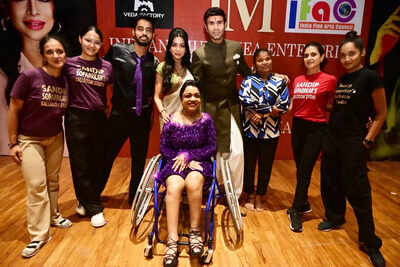- News
- Indrani Mukerjea Enterprise reimagines International Dance Day with an inclusive stagefor all abilities
Indrani Mukerjea Enterprise reimagines International Dance Day with an inclusive stagefor all abilities
At “Dance Is for Everybody,” curated by Indrani Mukerjea Enterprise and Sandip Soparrkar, performers across 17 disability categories redefined who gets to speak the language of dance.
On a warm Monday afternoon in Mumbai, the curtains rose slowly at Veda Kunba Auditorium—not to the thunder of trained limbs in perfect formation, but to the silent glide of a wheelchair carving arcs across the stage. It was the opening image of “Dance Is for Everybody,” a first-of-its-kind performance hosted by Indrani Mukerjea Enterprise (IME) and curated by renowned choreographer Sandip Soparrkar to mark International Dance Day.
Over the next sixty minutes, audiences witnessed something far more profound than a traditional dance recital: performers across India’s 17 recognised disability categories took the stage to demonstrate that movement—and the joy it carries— belongs to all bodies, not just able ones.
A day for dance. A stage for everyone.
This event echoed that spirit precisely. “Dance Is for Everybody” featured performers living with disabilities such as autism spectrum disorder, cerebral
palsy, muscular dystrophy, intellectual disability, speech and language disabilities, chronic neurological conditions, acid attack survival, Parkinson’s disease, mental illness, hearing impairments, visual impairments, leprosy cured status, dwarfism, specific learning disabilities, multiple disabilities, blindness, and locomotor disability.
“The word 'disability' contains within it the word 'ability' — and that's no accident. It reminds us that strength, creativity, and spirit are never absent. They are simply waiting to be seen,” said Indrani Mukerjea, who opened the event with a deeply personal reflection.
Each performance lasted 2–3 minutes, interwoven with poetry and spoken word led by Soparrkar, who acted as sutradhaar for the evening. The show unfolded as a unified narrative, rather than disconnected routines.
Inclusion, in sequence
The programme opened with a classical performance by children on the autism spectrum, followed by the national anthem in Indian Sign Language. Then came a dancer with Parkinson’s who folded tremors into tempo; a group of performers with cerebral palsy moving in choreographed symmetry; and an acid attack survivor stepping into the spotlight—each telling their story through motion, not monologue. The finale featured older dancers with Down syndrome in a vibrant Bollywood routine that brought the house to its feet.
“Dance is a language the body speaks long before words,” Soparrkar said. “When society listens, rhythm replaces indifference. That’s what happened here.”
A shared stage, not a transaction
A remarkable aspect of the event was that everyone involved contributed their time and talent free of charge. From performers and choreographers to the emcee and technical crew, each person came together in solidarity with the cause.
Ratan Pratap, who emceed the afternoon, helped thread the segments together with clarity and compassion, making space for each dancer’s presence to resonate fully.
“People often ask me how I dance without limbs. But dance begins long before the body moves. It begins with the will to express—and tonight, that was more than enough,” said Sumeet Jadhav, one of the performers at ‘Dance Is for Everybody’.
Following the final act, a brief press interaction was held where Mukerjea and Soparrkar reiterated the event’s purpose: not to dazzle, but to demonstrate—that dance is not reserved for perfection, but open to participation. No commercial partners were involved. No red carpet was rolled out. The applause belonged entirely to those who had once been left out of the room.
The rhythm ahead
“Dance Is for Everybody” was a prototype of what inclusive art can look and feel like seamless, dignified, and joyous.
Its message echoed far beyond the auditorium walls: disability does not disqualify; it expands the choreography of what’s possible. On a day that celebrates dance as a global language, this Mumbai stage reminded us that rhythm doesn’t begin in the feet—it begins in the heart.
“Long after the music fades, it is the courage we witnessed today that will keep echoing — like a drumbeat carried by the wind, like footsteps that never needed a perfect floor to dance. Today wasn’t just about performance. It was about presence — raw, real, and unforgettable,” said Mukerjea.
End of Article
Follow Us On Social Media








